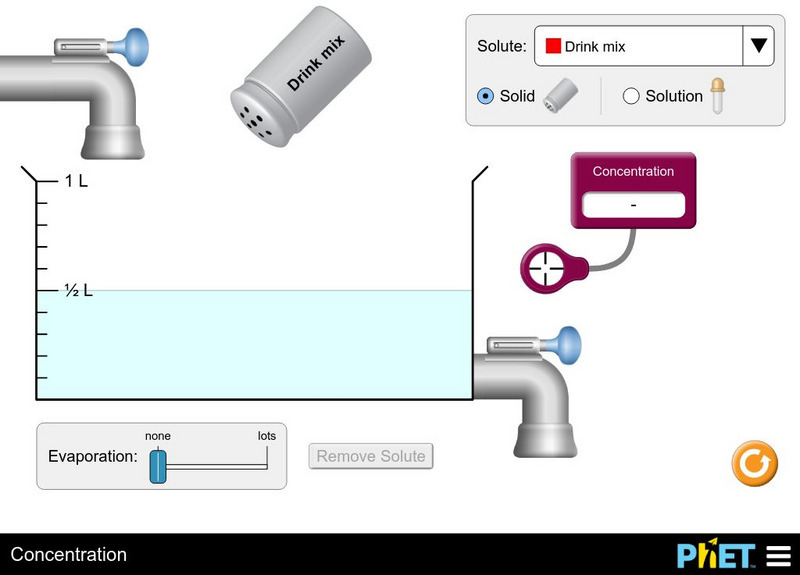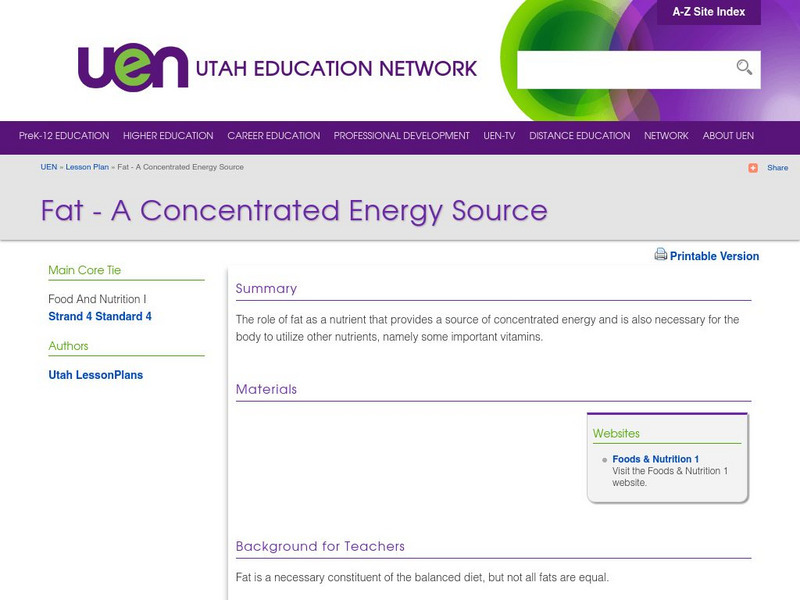Curated OER
Chapter 15 Review, Section 2: Acid-Base Titration and pH
Keep it simple with this chemistry assignment. Learners examine an acid-base titration graph and answer four questions about the data. Then they will balance neutralization equations and calculate molarity for several specific solutions....
Perkins School for the Blind
Mixtures and Solutions
Mixtures and solutions are different; one can be separated fairly easily and the other cannot. This hands-on experiment was written specifically for learners with visual impairments or blindness. They will use lemonade and trail mix to...
Curated OER
Lipids: Fats and Oils
A fantastic presentation with great images should improve student understanding of lipids and their involvement in the body. The chemistry of different fats, phospholipids, and steroids are explained. Additionally, the specific...
Curated OER
Lipids: Fats and Oils
A fantastic presentation with great images should improve student understanding of lipids and their involvement in the body. The chemistry of different fats, phospholipids, and steroids are explained. Additionally, the specific...
Carnegie Mellon University
Ocean Acidification
After brainstorming what they know about ocean acidification, youngsters place eggs in acid to determine the effects on calcium-containing organisms, and add carbon dioxide to solutions with sea shell material to discover the impact on...
Curated OER
Reading Comprehension: Obesity and Food Deserts
Read this selection about "food deserts," places where high poverty rates limit access to healthy foods with your class. Six multiple choice questions on comprehension, inferences, vocabulary, and citing the text follow the selection and...
Dick Blick Art Materials
Matisse Prints du Soleil
The sun provides the link between this art and science activity. Kids use sunlight (or light from an artificial source) to produce heliographic prints on fabric or paper.
NOAA
Ocean Zones
How can organisms light up in water? Bioluminescence is light produced in a chemical reaction that can occur in an organism's body. First, learners determine what happens to light/color as you move into the deep ocean. In groups, they...
Curated OER
Electrolytic Titration
Students observe an electrolytic titration using a conductivity tester. In this titration lesson, students observe a solution of acid conducting electricity using the conductivity apparatus. They observe the acid solution being titrated...
Curated OER
Solutions Review
In this solutions worksheet, students review the properties of solutions, the polarity of molecules, molarity, and solubility curves. This worksheet has 8 short answer questions and 15 problems to solve.
Curated OER
Mixing in the Kitchen
Learners identify the different types of mixtures. They identify examples of solutions, suspensions, colloidal dispersions, and emulsions through a game and basic experiments.
Curated OER
Elements Compounds and Mixtures
For this science worksheet, students apply science basic knowledge of chemistry to the puzzles that are listed for the four parts of the sheet while focusing upon the identification of a metalloid.
Curated OER
Enzyme Practice Sheet Key
In this enzyme worksheet, students solve 6 problems including questions about how enzymes work, graphs of the relationship between enzyme and substrate and structures of enzymes.
Curated OER
Kinetics and Equilibrium
In this kinetics and equilibrium worksheet, students use the diagram to answer the questions as it relates to endothermic or exothermic reactions. Students indicate the result in the reaction rate as speeding up or slowing down.
Curated OER
Helen Frankenthaler Biography
Learners examine the abstract art of Helen Frankenthaler. In this art analysis lesson, students complete a criticism of the aesthetics of the art, analyze the color use in the art, and research the history of abstract art.
Curated OER
Physiology Activity Perception and Behavior
Students conduct an experiment to determine a fly's ability to detect sugar, its behavioral response, how a previous experience may alter the response, if a fly can be tricked, and how human sensitivity compares to a fly.
Curated OER
Plotting the Petroleum Plume
Eighth graders examine the difference between confining layers and aquifers in a basic water table aquifer scenario. They contour groundwater elevation and petroleum product thickness data.
Curated OER
Groundwater Pollution Site Assessment
Students study how a geologist examines a hazardous waste spill using an actual site. They use site data to map the spill, find its source and determine how fast the spill is spreading.
Curated OER
Demonstrating That Light is Dissipated as Chlorophyll a Fluoresces
Students examine the concepts of light and chlorophyll. They participate in an experiment in which the chlorophyll shows as a red ring on the test tube. They answer discussion questions to end the lesson.
Curated OER
Barnet Atmosphere Adv Word Search Puzzle
In this science and language arts learning exercise, students analyze 30 words in a word bank which pertain to the atmosphere and weather. Students find the words in a word search. The meaning of the title is unclear.
University of Colorado
University of Colorado: Ph Et Interactive Simulations: Concentration
Watch your solution change color as you mix chemicals with water. Then check molarity with the concentration meter. What are all the ways you can change the concentration of your solution? Switch solutes to compare different chemicals...
University of Colorado
University of Colorado: Ph Et Interactive Simulations: Concentration
Learn how concentration, evaporation, and saturation affect the concentration of a solution.
Utah Education Network
Uen: Fat a Concentrated Energy Source
Through these lesson plans, young scholars explore and discuss the role of dietary fat as an important energy source. In addition to providing detailed instructions for teachers, this website includes all the handouts and charts needed...
University of Colorado
University of Colorado: Ph Et Interactive Simulations: Molarity
What determines the concentration of a solution? Learn about the relationships between moles, liters, and molarity by adjusting the amount of solute and solution volume. Change solutes to compare different chemical compounds in water.























